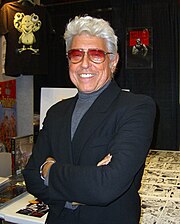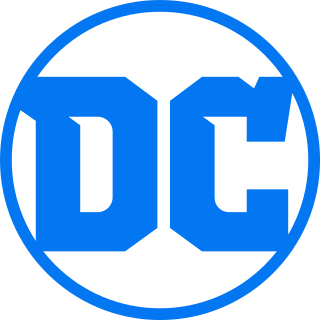
DC Comics, Inc. is an American comic book publisher and the flagship unit of DC Entertainment, a subsidiary of Warner Bros. Discovery. DC is an initialism for "Detective Comics", an American comic book series first published in 1937.

Superman is a superhero who appears in American comic books published by DC Comics. The character was created by writer Jerry Siegel and artist Joe Shuster, and debuted in the comic book Action Comics #1. Superman has been adapted to a number of other media, which includes radio serials, novels, films, television shows, theater, and video games.
A graphic novel is a long-form work of sequential art. The term graphic novel is often applied broadly, including fiction, non-fiction, and anthologized work, though this practice is highly contested by comics scholars and industry professionals. It is, at least in the United States, typically distinct from the term comic book, which is generally used for comics periodicals and trade paperbacks.
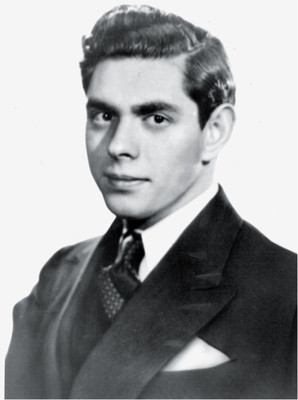
Joseph Shuster, was a Canadian-American comic book artist best known for co-creating the DC Comics character Superman, with Jerry Siegel, in Action Comics #1.

Quality Comics was an American comic book publishing company which operated from 1937 to 1956 and was a creative, influential force in what historians and fans call the Golden Age of Comic Books.
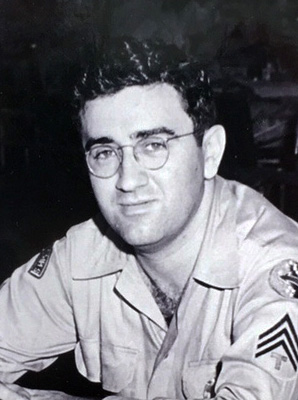
Jerome Siegel was an American comic book writer. He is the co-creator of Superman, in collaboration with his friend Joe Shuster, published by DC Comics. They also created Doctor Occult, who was later featured in The Books of Magic. Siegel and Shuster were inducted into the comic book industry's Will Eisner Comic Book Hall of Fame in 1992 and the Jack Kirby Hall of Fame in 1993. With Bernard Baily, Siegel also co-created the long-running DC character The Spectre. Siegel created ten of the earliest members of the Legion of Super-Heroes, one of DC's most popular team books, which is set in the 30th Century. Siegel also used pseudonyms including Joe Carter and Jerry Ess.

James F. Steranko is an American graphic artist, comic book writer/artist, comics historian, magician, publisher and film production illustrator.

The Spirit is a fictional masked crimefighter appearing in American comic books. Created by cartoonist Will Eisner, he first appeared as the main feature of a tabloid-sized comic book insert distributed in the Sunday edition of Register and Tribune Syndicate newspapers. Popularly referred to as "The Spirit Section", the insert ran from June 2, 1940 to October 5, 1952.

Samuel Emerson "Slam" Bradley is a fictional character that has appeared in various comic book series published by DC Comics. He is a private detective who exists in DC's main shared universe. The character concept was created by DC Comics founder Malcolm Wheeler-Nicholson and developed by Jerry Siegel and Joe Shuster, who both later became more well known as the co-creators of Superman. As one of the first ever DC characters, the character first appears in the Golden Age of Comic Books in the anthology title Detective Comics, being introduced in the first issue. He later commonly was associated with Batman and other spinoff Batman characters when revived.

Chandler: Red Tide is a 1976 illustrated novel, an early form of graphic novel, by writer-artist Jim Steranko.
Centaur Publications was one of the earliest American comic book publishers. During their short existence, they created several colorful characters, including Bill Everett's Amazing-Man.
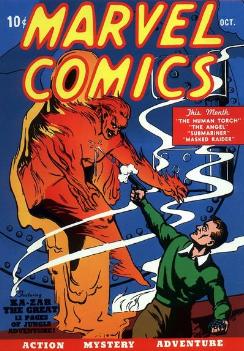
Funnies, Inc. was an American comic book packager of the late 1930s to 1940s period collectors and historians call the Golden Age of Comic Books. Founded by Lloyd Jacquet, it supplied the contents of early comics, including that of Marvel Comics #1, the first publication of what would become the multimedia corporation Marvel Comics.

Everett M. Arnold, also known as Busy Arnold, was an American publisher and an early comic-book entrepreneur whose company Quality Comics published during the 1930s and 1940s period fans and historians call the Golden Age of Comic Books. He was also instrumental in the publishing arrangement that led to Will Eisner's newspaper Sunday-supplement comics series The Spirit.
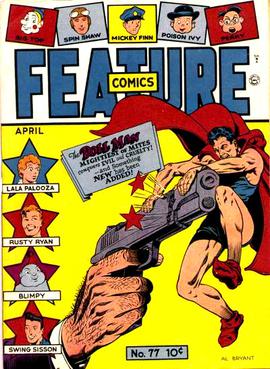
Feature Comics, originally Feature Funnies, was an American comic book anthology series published by Quality Comics from 1939 until 1950, that featured short stories in the humor genre and later the superhero genre.

The Academy of Comic Book Arts (ACBA) was an American professional organization of the 1970s that was designed to be the comic book industry analog of such groups as the Academy of Motion Picture Arts and Sciences. Composed of comic-book professionals and initially formed as an honorary society focused on discussing the comic-book craft and hosting an annual awards banquet, the ACBA evolved into an advocacy organization focused on creators' rights.
Eisner & Iger was a comic book packager that produced comics on demand for publishers entering the new medium during the late-1930s and 1940s, a period fans and historians call the Golden Age of Comic Books. Founded by Will Eisner and Jerry Iger, many of comic books' most significant creators, including Jack Kirby, entered the field through its doors. Eisner & Iger existed from 1936 to 1939.
Ken Landgraf is an American comic book artist and commercial illustrator.
In 1938, Jerry Siegel and Joe Shuster gave away the copyright to Superman to Detective Comics, Inc., the predecessor of DC Comics. In 1948, National Comics settled ownership and royalties disputes and paid $94,013.16 for Superman and Superboy rights. In 1969, a court ruled that Siegel and Shuster's grant of copyright included their renewal rights. Shuster died in 1992 and his heirs re-granted their rights for a $25,000 annual stipend. In 2001, the Siegel heirs took back their rights using the termination provision of the Copyright Act of 1976 and accepted a new purchase offer from Warner.
National Comics Publications and All-American Publications, two precursors to DC Comics, were formed publishing American comic books such as superhero comics starting in the 1930s. Primary Comic book anthology titles created by the company was More Fun Comics, Adventure Comics, Detective Comics, Action Comics, All-American Comics and Superman. Other companies like Quality Comics and Fawcett Comics would later be merged into DC. Quality started by introducing comic books like Feature Comics and Smash Comics.
George "Jimmy" Orlando Thompson was a Canadian comic book artist during the Golden Age of Comic Books. He worked for many companies throughout his career including DC Comics, Timely Comics, Marvel Comics, Fawcett Comics, David McKay Publications, and King Features Syndicate.

